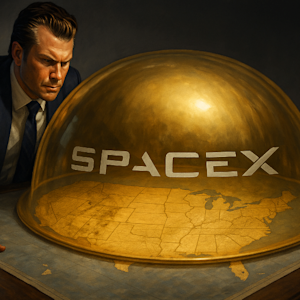Buffett’s Bind
![]() Buffett’s Bind, Your Opportunity
Buffett’s Bind, Your Opportunity
 The biggest question about the future of Berkshire Hathaway is now settled. The second-biggest question is still completely up in the air.
The biggest question about the future of Berkshire Hathaway is now settled. The second-biggest question is still completely up in the air.
As perhaps you’ve heard, Warren Buffett announced on Saturday during BRK’s annual shareholder meeting in Omaha, Nebraska that he’s hanging it up as CEO.
Assuming the board goes along with his wishes, his designated successor Greg Abel takes over at the start of 2026 — at which time Buffett will be 95.
We won’t dwell on the changing of the guard, because you can read that anywhere.
Nor will we spend much time on Buffett’s other comments over the weekend — except for an interesting juxtaposition.
He knocked the president’s tariff policy: “Trade should not be a weapon.”
But at the same time, he suggested there’s nothing about what’s happening in Washington today that alters his perennial optimism about America: "If I were being born today, I would just keep negotiating in the womb until they said, ‘You could be in the United States.’”
 Now, about that second-biggest question…
Now, about that second-biggest question…
It has to do with the stupendous amount of cash on BRK’s balance sheet — a record $348 billion. That’s almost 30% of the company’s $1.2 trillion market cap.
Why has Buffett been so hesitant to put that cash to work?
On Saturday, he said what he’s always said whenever BRK’s cash pile was historically high: He’d readily put that cash to work if he could pick up a business that offered good value and that he’d want to hold long-term. Along those lines, he said it would be the “dumbest thing in the world” to drop $50 billion just for the sake of shrinking BRK’s cash holdings.
 A better, more satisfying answer to the question is one that Buffett did not dwell on this weekend — but has in the past.
A better, more satisfying answer to the question is one that Buffett did not dwell on this weekend — but has in the past.
As far back as the early 1990s, Buffett acknowledged the sheer size of Berkshire was such that it could no longer invest in smallish companies with explosive growth potential.
It was those sorts of investments that helped BRK achieve an annual average return of 15% from 1956–1993 — an unparalleled stretch of profitability.
He expounded on this victim-of-his-own success phenomenon in 1999 — another time he was sitting on a substantial cash pile. “If I was running $1 million today, or $10 million for that matter, I’d be fully invested,” he said. “It’s a huge structural advantage not to have a lot of money.”
As such, “The universe I can’t play in has become more attractive than the universe I can play in. I have to look for elephants. It may be that the elephants are not as attractive as the mosquitoes. But that is the universe I must live in.”
 Important point: Buffett can’t operate in that universe — but even with just a modest grubstake, you can.
Important point: Buffett can’t operate in that universe — but even with just a modest grubstake, you can.
That’s critical at a time when Paradigm’s own James Altucher — who wrote a book called Trade Like Warren Buffett — sees a major shift coming for markets this month.
As James warned many of our readers during April, “The stocks that went up in the last rally are not the same ones that will lead the market higher this year.”
What are the stocks that went up in the last rally? The “Magnificent 7” — the Amazons, the Apples and such.
Buffett knows what James knows: That’s why Berkshire bailed from a substantial portion of its AAPL position during 2024.
But while Buffett is hamstrung and has to content himself with collecting a 4% yield on his cash… you can put cash to work in the companies Buffett can’t.
James is guiding his Microcap Millionaire readers to the very best opportunities that will lead the market for the rest of 2025.
If you’re not among them, you should know James anticipates an urgent catalyst for these lucrative names that could power them to gains of 1,000% or better. And that catalyst will begin to play out this Wednesday afternoon — for reasons he’ll show you when you click here.
![]() Dispatches From the Trade-War Front Lines
Dispatches From the Trade-War Front Lines
 “What a number of retailers are telling me is that they have about five–seven weeks of normal inventory levels remaining,” says Gene Seroka, who runs the Port of Los Angeles.
“What a number of retailers are telling me is that they have about five–seven weeks of normal inventory levels remaining,” says Gene Seroka, who runs the Port of Los Angeles.
“If nothing changes, then we’ll start seeing fewer selections on the store shelves and on websites as we try to buy online,” Seroka tells Bloomberg TV. “And that will also cause price increases.”
As for the sprawling operation he oversees — the Port of Los Angeles — he says arrivals this week “will be down 35%-plus percent year over year.
“Major retailers, home-improvement stores and even manufacturers who source parts from China are saying that imports from that country have all but stopped because the price of products made in China now is 2½ times what it was last month. And they just can’t justify that.”
 And yet Donald Trump remains nonchalant about the prospect of imports from China drying up.
And yet Donald Trump remains nonchalant about the prospect of imports from China drying up.
Asked about it on NBC’s Meet the Press this weekend, he came back to the “dolls” example we mentioned here on Friday.
"I don't think a beautiful baby girl that's 11 years old needs to have 30 dolls,” he said. “I think they can have three dolls or four dolls... they don't need to have 250 pencils. They can have five."
It’s not the first time Team Trump has trotted out this curious line of argument. Said Treasury Secretary Scott Bessent in March: "Access to cheap goods is not the essence of the American dream."
Well, no. But considering that a middle-class existence is increasingly out of reach for many Americans — perhaps the primary reason Trump was elected last year in the first place — “cheap goods” are one of the few things Americans still have to hang onto between now and the time America’s industrial glory days are supposed to be restored…
 Meanwhile, Bessent’s hopes of lining up other U.S. trading partners to achieve a “grand encirclement” of China look increasingly shaky.
Meanwhile, Bessent’s hopes of lining up other U.S. trading partners to achieve a “grand encirclement” of China look increasingly shaky.
A few weeks ago, he described a scheme involving the governments of several large Asian economies as a group — Japan, South Korea, India, Vietnam.
“They’ve been good military allies, not perfect economic allies,” he said. But after reaching trade deals with them, “then we can approach China as a group.”
Reminder: 64 days remain in the Trump administration’s 90-day pause on its “reciprocal” tariff regime — time in which to make deals with dozens of countries.
From the start, Japan seemed like the most likely candidate for an early deal. Tokyo sent a delegation to Washington within days of the pause announcement. A second round of talks took place last week.
 But it’s a long way from here to a done deal with Japan.
But it’s a long way from here to a done deal with Japan.
After the second round of talks, Tokyo’s top negotiator Ryosei Akazwa put it like this: "We have been telling them that the entire series of tariffs are regrettable and have strongly insisted they be revised.
“Unless this demand is acknowledged in an ultimate package, there is no way we can agree to a deal."
That’s a long list of unresolved issues — tariffs on everything from cars to auto parts to steel and aluminum, to say nothing of the so-called reciprocal tariffs.
On Friday, the man at the top — Prime Minister Shigeru Ishiba — left a not-so-subtle hint about the lack of progress. He said any additional tariffs on Japanese cars are “absolutely unacceptable.”
To be continued…
![]() Trump’s Vietnam Moment (Again)
Trump’s Vietnam Moment (Again)
 “Trump can’t afford to become consumed by Ukraine if he wants to achieve the rest of his agenda on trade, immigration and real growth,” Jim Rickards reminded his Strategic Intelligence readers on Friday.
“Trump can’t afford to become consumed by Ukraine if he wants to achieve the rest of his agenda on trade, immigration and real growth,” Jim Rickards reminded his Strategic Intelligence readers on Friday.
Since February, Jim has warned that Trump faces a “Vietnam moment” — in which a war waged by a previous president becomes an albatross around the current president’s neck unless the current president acts swiftly.
“The danger for Trump is that if he cannot end the war quickly, it will go from being Biden’s war to Trump’s war in the eyes of the American people,” says Jim.
“Putin’s demands have not changed since the war began. They are: Ukrainian neutrality, demilitarization, de-Nazification and no NATO membership. These demands are clear and nonnegotiable. What is negotiable is the extent of Ukrainian territorial loss. Let’s hope Trump sees reason and basically agrees to Putin’s terms with some face-saving measures.”
 But the new minerals deal with Ukraine appears to tie Trump to the hip of Ukraine’s leader Zelenskyy.
But the new minerals deal with Ukraine appears to tie Trump to the hip of Ukraine’s leader Zelenskyy.
We’re learning a few additional details about the agreement signed last week. It seems future U.S. military aid to Ukraine will count as a contribution to a joint U.S.-Ukrainian “investment fund” to develop Ukraine’s mineral wealth.
No sooner was the ink dry that the Trump administration approved a $50 million arms sale to Kyiv. That was followed by State Department approval of an additional $311 million in arms sales — mostly for pilot training and maintenance of American-made F-16s.
Those aren’t large numbers in the scheme of the $175 billion in aid to Ukraine that Congress has approved since 2022.
But it does reinforce the language Treasury Secretary Bessent used when signing the minerals deal, language that harked back to the Biden era: “This agreement signals clearly to Russia that the Trump administration is committed to a peace process centered on a free, sovereign and prosperous Ukraine over the long term… And to be clear, no state or person who financed or supplied the Russian war machine will be allowed to benefit from the reconstruction of Ukraine.”
 Meanwhile, Trump took a huge slap at Moscow on Friday, whether he intended to or not…
Meanwhile, Trump took a huge slap at Moscow on Friday, whether he intended to or not…

There is no way the Kremlin could interpret that except as an insult.
As we said on the occasion of V-E Day last year, the Soviets suffered 27 million dead in World War II compared with just over 400,000 Americans.
Really, the Allies’ victory at Normandy over 11 Nazi divisions was made possible only because the Soviets tied down another 228 Nazi divisions on the Eastern Front.
Russia will mark the 80th anniversary of V-E Day on Friday with a huge military parade, as usual. In 1995, Bill Clinton went to Moscow to take part in the 50th anniversary commemoration. George W. Bush did the same for the 60th in 2005.
For the 80th, the list of foreign dignitaries in attendance will include… China’s Xi Jinping.

If there was ever any hope that Trump could somehow split the Russia-China friendship — which Xi has described as “stronger than an alliance” — it’s over now.
![]() Oil at New 4-Year Lows
Oil at New 4-Year Lows
 The big market story today is the price of crude plunging to its lowest since early 2021.
The big market story today is the price of crude plunging to its lowest since early 2021.
The OPEC+ nations can’t seem to get their act together on production targets. Over the weekend, Saudi Arabia and Russia — the top global producers after the United States — agreed to raise output by triple the volume previously scheduled.
With that, a barrel of West Texas Intermediate is under $57.
That’s good news if you’re planning a driving trip soon. Not so good if you’re an American oil company. And maybe not so good for the Trump administration’s agenda, either.
As we mentioned last month, the White House no doubt welcomes lower oil prices. But if they get much lower than this, some wells will cease to be profitable and their operators will cap them. Which would have the effect of constraining supply and pushing prices back higher.
(This phenomenon is captured by a common saying among commodities traders: “The cure for low prices is low prices.”)
 Meanwhile, the U.S. stock market’s rally is taking a breather.
Meanwhile, the U.S. stock market’s rally is taking a breather.
After nine-straight winning sessions — enough to wipe out all the market’s losses since the “Liberation Day” announcement on April 2 — the S&P 500 is slightly in the red. At last check, the index is down a quarter percent to 5,672. The Nasdaq’s losses are steeper, while the Dow is slightly in the green.
Gold is starting the week on another furious rally. As we write, it’s up nearly $70 and back above $3,300. Silver’s rally is weaker (what else is new?) but it’s back over $32.
Bitcoin is in retreat — barely above $94,000 after surpassing $97k toward the end of last week.
![]() Mailbag: DOGE’s Impact?
Mailbag: DOGE’s Impact?
 One of our regular readers chimed in after we took note of the April job numbers and the relatively few cuts to the federal payroll the last two months…
One of our regular readers chimed in after we took note of the April job numbers and the relatively few cuts to the federal payroll the last two months…
“According to your DOGE update,which had a grammar mistake, the total in my math is 13,000 multiplied by $100,000 average salary and benifits for government employes is a Billion three hundred million. Not negligible in my book. That is a savings every year! Love the Five!
“P.S. Correct me if I'm wrong.”
Dave responds: Hmmm… $1.3 billion out of a $6.7 trillion annual budget? Feels like small beer.
The Office of Personnel Management says the average annual pay across the entire federal workforce is $106,382.
If the federal workforce totals 2.4 million (not including the Postal Service) and you get rid of everyone, you’re looking at $256 billion out of a $6.7 trillion annual budget. Still not that much!
I wouldn’t harp on it except that the DOGE boys kept making a huge deal at the outset of this administration about all the jobs they were cutting. Now granted, some of those cuts have gotten tied up in the courts, but still… you’d think there’d have been more progress by now?
(Oh, we’re still looking for the grammar mistake…)
Best regards,

Dave Gonigam
Managing editor, Paradigm Pressroom's 5 Bullets










